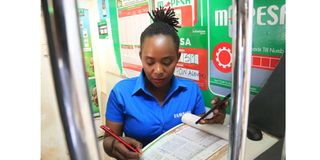Bankelele: Financial habit changes in 2021

An attendant makes an M-Pesa transaction for a customer.
Kenya had come a long way in the world of cashless payments, but all that accelerated with Covid-19.
Before March 2020, I had never done a “bank to mobile” transaction. I thought it was frivolous for a bank to charge almost Sh100 to transfer from one wallet to another. It was better to walk to an ATM for a free transaction than pay the charge.
But last March, Central Bank waived charges on “bank to mobile” transactions, and on transfers below Sh1,000. This was part of a push towards cashless and contactless payments to help contain the spread of Covid-19. And since then, we have got used to free transfers and payments as mobile phone companies have made it cheaper to make payments within wallets.
For many people, payments are done by mobile money or card, and it is now routine to go around Nairobi every day without having a banknote. Covid-19 has accelerated cashless payments and with that, it is time to redesign men’s wallets. Of what use is a bulky wallet now?
There have been shifts at companies to embrace cashless and contactless interactions with their customers through online ordering. Newspapers, pharmacy drugs, weekend drinks, restaurant meals, seasonal fruit, fresh fish and other goods that one would go to the market for are all being delivered to homes now.
Missed opportunities
Still, amid the improvements in 2020, there have been some missed opportunities to migrate to even more cashless and contactless payments.
Using mobile money to pay for goods remains cumbersome. It takes many steps, reading and typing several numbers, and confirming business names. It is tolerated now because alternatives for cash are scarce.
The other is in public service vehicles – buses and matatus – that have largely remained cash collectors all through the Covid period. The only time I carry cash these days is when I plan to use a bus or matatu. They insist on cash, despite the difficulty of paying with banknotes these days. If you remove a note larger than Sh200, getting change can be a time-consuming chase. A solution is to ask if you can send M-pesa to the tout's number and have him sort out the balance later.
There have been some steps in the past to address these gaps. In May 2013, Equity Bank and Google launched cashless payments for buses called BebaPay. Also, in May 2017, Safaricom launched single tap payments for M-Pesa. These products fizzled out due to various reasons, but maybe they were also ahead of their time, as often happens in the world of technology where timing can be the difference between the failure or success of a company’s product.
But now that mobile money payments below Sh100 will be permanently free, perhaps that may provide the opportunity for matatus and SMEs to embrace cashless and contactless payments.
There are other hurdles too, mainly around cost. Paying by mobile money, or checking a bill balance, is often quite expensive. The fees charged may look small but they are unsuited to the service. When you want to pay for electricity and can only afford to spend Sh300 on tokens, 10 per cent of that should not be a transaction fee. Same with school fees and government services on ecitizen that also attract significant fees and taxes.
Another missed opportunity is in richer mobile money statements, that, instead of mimicking bank statements, are made more useful with interactive data like maps and web links.
As more payments shift online from being cash ones, there is an opportunity to use the transaction data to create creditworthiness statement on individuals and small businesses for them to access more credit and at lower borrowing costs.





